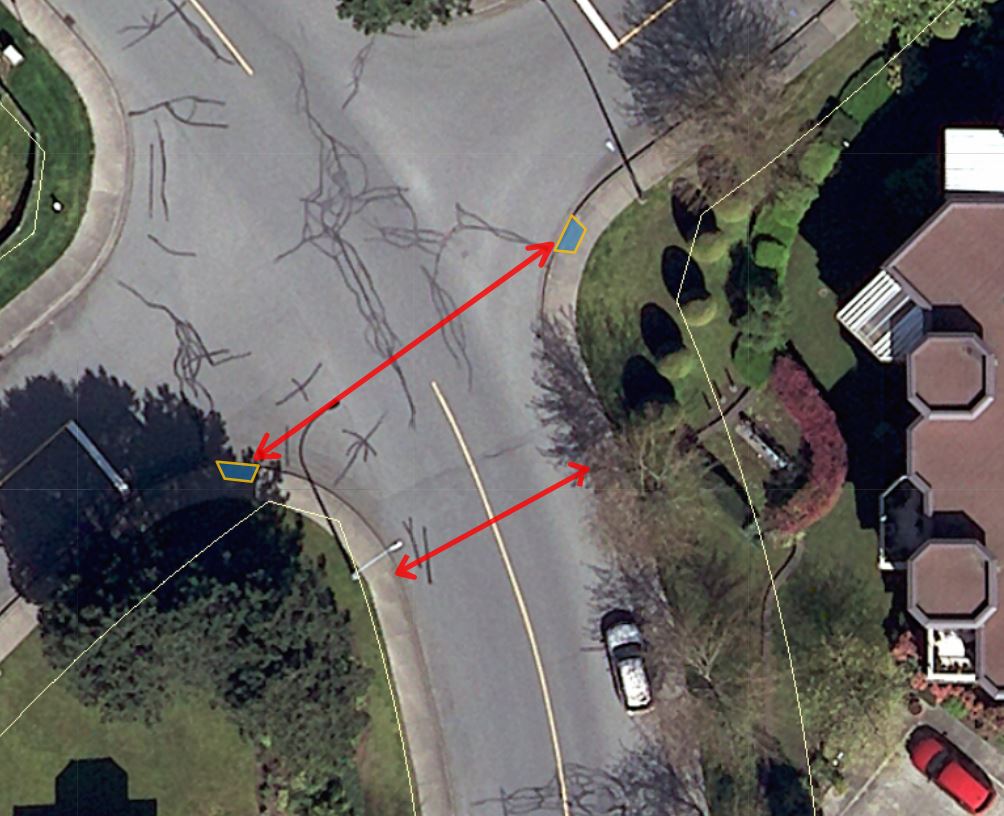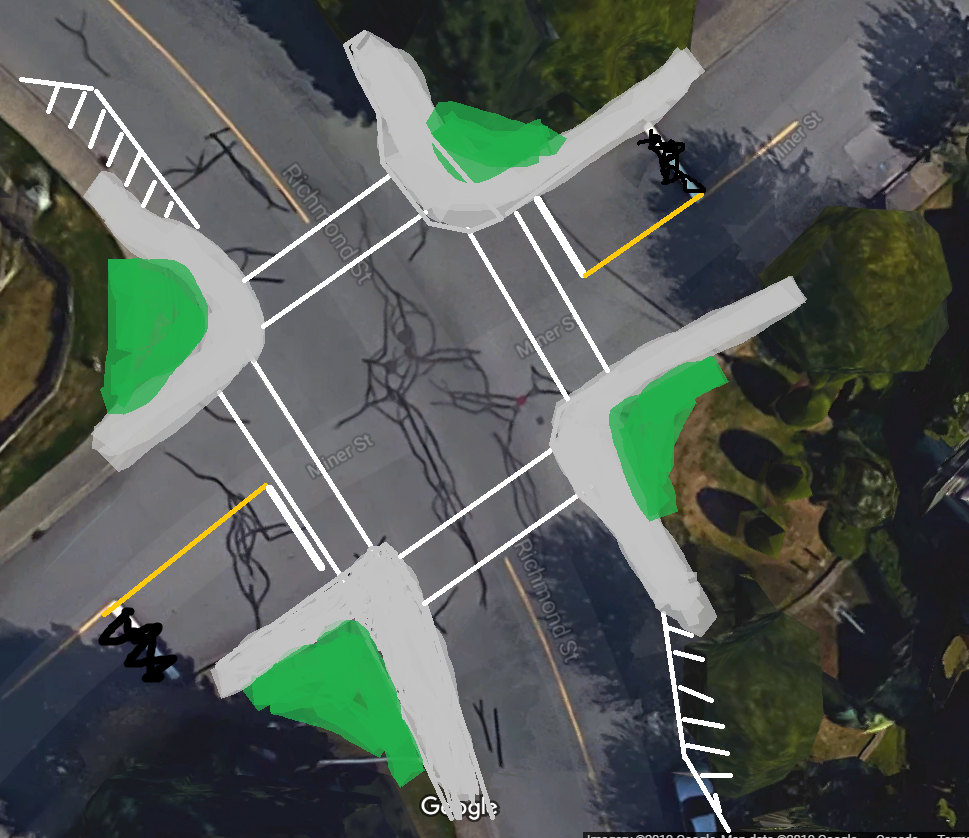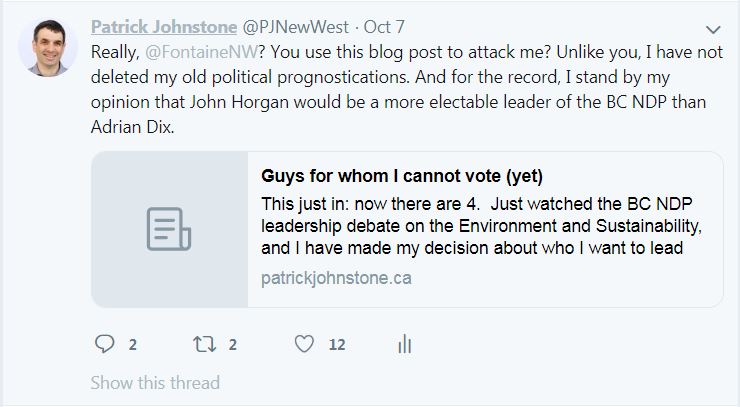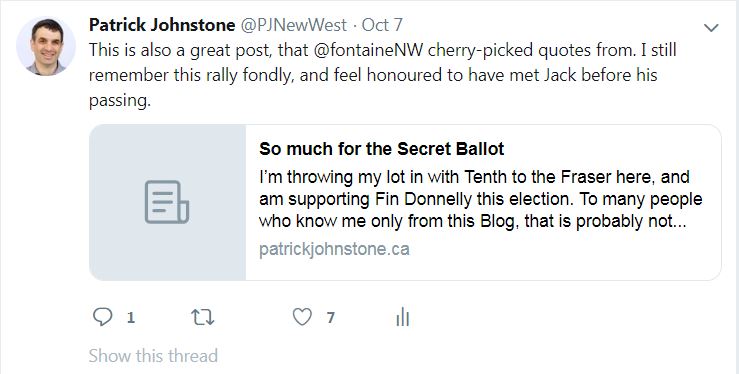Our Council meeting on March 11 had its share of pageantry and drama, and much of it was after the annual May Queen draw. Alas, I don’t have time to blog at length about what got me hot under the collar during the Opportunity for Public Comment, as meta as it may have been, and you will have to watch the video to get the full experience. Still we had a packed agenda that started with an Opportunity for Public Comment:
Draft 2019 – 2023 Financial Plan
As discussed in workshop and blogged about at length, we have a proposed 2019 budget and 5-year financial plan. As always, between the public workshop where we discussed at length and made decisions about the discretionary parts of the financial plan, we accept correspondence and have a public opportunity to comment. The e-mail correspondence we received on the Financial plan was about 38 pages (almost all of it comprising questions from a single person that staff patiently responded to as best they could). We also had about a half dozen members of the public come to speak, assuring that the voice of the middle aged white man was well represented. I agree strongly with some of the input we received – two delegates mentioned that cities and (in turn) property tax payers are being unfairly burdened for the cost of local infrastructure when there are more progressive taxation types such as income tax available to senior governments, though little of that trickles back to local governments. I also strongly disagree with a person who receives 30-plus pages of responses from staff then is given a public forum to ask questions of Council complaining that this is a secretive and closed process.
Anyway, the Financial Plan will need to come to us in the form of the Bylaw, which will occur in April. I will blog more about the final financial plan at that time.
The following items were Moved on Consent:
Urban Indigenous Engagement around the development of the New Westminster Aquatic and Community Centre
This is a short report on the efforts staff are taking to engage the local indigenous population in planning for the new Aquatic and Community Centre (the project name of the replacement for the Canada Games Pool and Centennial Community Centre). It will be interesting to work through this framework and find what works and what doesn’t as we are going into a broader-reaching Truth and Reconciliation process in the City.
Recruitment 2019: Committee Appointments (SAC, NTAC, RJC, and ACTBiPed)
These are regular adjustments to various council advisory committees. People move, people (alas) pass away, and people shift their volunteer priorities, but advisory committees go on. We have named new representatives to these committees.
310 Salter Street (Port Royal Phase 6B): Development Permit and Development Variance Permit for Mid Rise Multi Unit Residential Development – Consideration of Notice of Opportunity to be Heard
One of the final pieces of the Port Royal development is an 87 unit 4- to 6-story residential complex on Salter Street. The proposed complex of three buildings meets the FSR and is smaller than the allowable maximum lot coverage, but requires variances for height and setbacks. There will be an Opportunity to be Heard on this on April 8th. C’mon out and tell us what you think.
Connaught Heights Park Playground Redevelopment – Preferred Option
The playground adjacent to Connaught Heights School needs to be refurbished. There was a pretty extensive child-centred community consultation, and a final plan is now proposed, for a mixed use playground to appeal to all ages nestled within the existing mature trees on site. The construction will take place while school is out for the summer, to reduce the impact on the students.
Vimy Heritage Oak Trees Proposal
There is an organization that preserves and propagates oak trees grown from acorns collected from Vimy Ridge shortly after the WW1 battle for the ridge ended. Working with the New West Heritage Preservation Society, there are two saplings to be planted on the front lawn of City hall to frame the Cenotaph and formal commemoration space.
2019 Environmental Grant Recipient – Project Scope Change
The plan to put together a documentary film on the history of the preservation of the Brunette River have been shelved for some creative and logistical reason. The City provided a bit of grant money for that project, but the organizers would now like to use those funds to create more educational multi-media materials on the same theme. I support this, as it is a story that needs to be told, and I think the mixed media proposal will reach a broader audience than the film.
We then had a couple of pieces of New Business:
Queen’s Park Sportsplex – Conceptual Design
After much too long of a wait, we have moved the Arenex replacement to final design. This has been a challenging project for several reasons, including details about insurance. The building that will start construction this spring in Queens Park will not have the old-timey charm of the Arenex, but will be a much more functional building for the primary user groups. The majority of the cost (about 80%) of the replacement will be covered by the insurance claim for the Arenex, though we will need to top it up a bit, mostly from a grant fund we have been holding in reserve for sports facilities in the City.
Climate Action in the City of New Westminster
This was a motion on notice form Councillors Nakagawa and McEvoy, which was well supported by a large delegation of community leaders from the Force of Nature Alliance. It is worth reading in its entirety:
WHEREAS The earth is currently on track to warm by more than 3 degrees Celsius; and
WHEREAS An October 8, 2018 report from the Intergovernmental Panel on Climate Change (IPCC) finds that it is necessary to limit global warming to 1.5 degrees Celsius, rather than 2 degrees as previously understood, and that doing so “would require rapid, far- reaching and unprecedented changes in all aspects of
society,” and that we have until 2030 to undertake these changes; and
WHEREAS The IPCC report puts the benchmark for greenhouse gas reduction targets for corporate and community-wide emissions at 45% by 2030, 65% by 2040, and 100% by 2050;
WHEREAS The British Columbia government declared a provincial state of emergency in 2018 over record-setting wildfires; and
WHEREAS The Legislature of British Columbia and the House of Commons of Canada have acknowledged the growing crisis of climate breakdown by holding emergency debates following the release of the IPCC report; and
WHEREAS Local governments worldwide are taking action to avoid the worst impacts of climate change and calling on senior levels of government for an urgent, emergency response; and
WHEREAS The costs to New Westminster for dealing with the impacts of climate change – including sea level rise – are significant; and
WHEREAS The most vulnerable members of our community are the most impacted by the effects of climate change; and
WHEREAS The City of New Westminster has been taking action on sustainability through the Environmental Strategy and Action Plan, Community Energy and Emissions Plan, and Envision 2032;
THEREFORE BE IT RESOLVED
THAT Council recognize that climate change constitutes an emergency for the City of New Westminster; and
THAT Council direct staff to report back on how the following action items can be implemented:
1. Update existing City plans with new targets as per the IPCC report;
2. Increase ambition and/or accelerate timelines for existing actions under the Environmental Strategy and Action Plan and the Community Energy and Emissions Plan;
3. Consider new actions to help the City achieve its targets;
4. Consider new actions that would help reduce GHG emissions beyond the scope of the City’s current climate targets;
5. Track and report on community emissions;
6. Engage the community in discussion on how to drastically reduce GHG emissions with particular focus on those most vulnerable to climate impacts and most in need of support in transitioning to renewable energy;
7. More broadly communicate with the community about City emissions and targets;
8. Implement a carbon budget; and
THAT Council direct staff to include climate action for consideration within the City’s strategic plan that is currently being developed.
I don’t have much to add to that, except that I struggled with considering if we should do this before or after we had completed our Council Strategic Planning work to set out goals for the term. It was Councillor Nakagawa who convinced me that the Climate emergency needs to frame our Council goals, because vice-versa is how we have always operated as a City, as a province, and as a country, tacking on climate as just one more thing we need to deal with. This is the existential struggle of our age, perhaps the first truly global existential struggle. We need to act, and act with purpose.
The following items were Removed from Consent for discussion:
Cannabis: New Retail Store Application Evaluation
As we discussed at some length last summer, the City has put together some guidance and community standards for cannabis retail operations that wish to open in #NewWest. After receiving 22 completed applications for these businesses, staff used a ranking system to prioritize 5 applications to be reviewed together as an initial tranche, one in each of Downtown, Uptown, Sapperton, 12th Street and Queensborough. These 5 will still need to go through a Zoning Amendment Bylaw, which should happen in April (no, not on the 20th), and if everything goes well with the City, the Liquor and Cannabis Regulation Branch, and the applicants, we should have our first stores opened by the summer.
There were many delegates who came to speak to this process, all of them representing businesses that did not make the scoring cut, or were ranked lower than their competitors. However, I hold the opinion that the process was clear and fairly adjudicated. This was not going to be an easy process, and the gold rush mentality about this new industry makes these conversations difficult. Although I think the process was more fair and accountable than the alternate “lottery” process for choosing first wave applicants, it was inevitable that some would not be chosen – even really good applicants. Everyone, successful and otherwise, put serious money and time into the application process, and as with cutting-edge entrepreneurs, really put their heart in it as well. The quality of the applications showed this.
The 5 applicants who got through this first screening will still need to go through Zoning and business license approvals, so there is some work to do yet, and there will be a Public Hearing, so I am going to hold my comments about individual applicants until then.
Interesting to note that there are still some issues to work out with the Province on regulation of these businesses. The LCRB wants these stores to have opaque windows, but for both community design and safety reasons, opaque windows are no longer favoured in retail zones. This is something we need to work out with the LCRB.
Naming of Two New Streets in Queensborough
We have two new streets being created in Q’Boro, so they need names. The Community Heritage Commission and Queensborough Residents Association were consulted, and the names Kamachi and Ota rose to the top of the selections, honouring the memory of two prominent families in the earlier history of the ‘Boro.
330 East Columbia Street (Royal Columbia Hospital Project): Update on Rezoning to Allow for the Renovation, Redevelopment and Modernization of Hospital Facilities
RCH needs to do a rezoning for the next phases of development on the site, which will require some staff and committee review of things like setbacks, height, density and massing, transportation requirements, and design elements. It will go through some committee review and public consultation in April. Phase 2 of the RCH Project is the big one –with a new Acute Acre tower that will be the largest building on site. Folks in Sapperton especially should spend a bit of time getting to know this project and its potential impact on their neighbourhood.
The movement of Ambulance access to the Sherbrook Street side of the building is sure to be something Lower Sapperton residents are going to have opinions on, but the maintenance of a pedestrian and cycling connection through the campus from the Sapperton SkyTrain Station to lower Sapperton is a positive idea.
I also took a moment to reiterate that East Columbia cannot be the primary road access for staff and visitors of this major acute care hospital. The community’s dreams of East Columbia as a great street supporting a vibrant commercial district mean we need to reduce this traffic load on that road, not increase it. The only alternative is for the regional traffic accessing the hospital (and adjacent commercial development at the Brewery district) to have direct access from Brunette Avenue, which would require a light-controlled intersection at Kearey, Allen, or Sherbrook. This will be a tough sell to regional traffic mongers like the Trucking Association and the Gateway Council, but regional traffic on regional roads is the primary plan for not just New Westminster and Sapperton, but for the entire Greater Vancouver region. This is a fight worth having, and we need to get Fraser Health on side with it.
Proposal for Public Realm Improvements in Brow of the Hill at 1010 Fifth Avenue
Another small parklet in the Brow of the Hill Neighbourhood, where the City has some of the greatest density and least access to public green space. Little hubs like this can really make an apartment-centric neighbourhood a home. I’m happy to support them, and happy that Councillor Nakagawa (a champion for the Brow before it was cool!) called for a more “green” design.
Quayside Tugger Pilot House: Removal and Replacement Project
With mixed feelings, I am sorry to report Tugger has to go. She served us well for 30+ years, but rusting structural elements are taking their toll. The underlying decking needs significant structural intervention, and that simply cannot happen without deconstruction and removal of the ol’ tetanus tug.
The good news is that a new play structure is planned and will be installed in his spring, thanks to support from the local Rotary Club in memory of long-time member Dr. Irwin Stewart (who provided $50,000 for the project), and Bosa (who are doing the deck repairs).
The design is a bit controversial, just as most every other playspace is when seen as a rendering and as a replacement for what we are used to. But I like the nod to the old tug, and the creative use of the main evidence that the Fraser is still a working river – a heaping barge – as the foundation for an all-ages tumble space.
Downtown Dog Off-Leash Area – Partial Relocation
The downtown off-leash area has been in place since 2009, but the land it is on does not belong to the City, and with a new building on part of the lot and a new memorial park planned for the site, we need to move the urban dog park.
We went through some public consultation, and dog parks are always exciting and challenging public consultations for a variety of reasons. However, the best current option is to put a dog run at Simcoe Park.
I am challenged by the idea that we won’t have a dog park below Royal Avenue. I am asking staff to continue to look for opportunities downtown, recognizing we don’t have much City-owned land in the downtown, but a lot of people in apartments have dogs, and need this service. I have a few ideas that I hope staff will explore, but I’m not going to share them now because I honestly don’t know the practicality of feasibility of either site, and I don’t an to set expectations. There is work to do here…
Finally, we adopted the following Bylaws
Engineering User Fees and Rates Amendment Bylaw 8097, 2019
Cemetery Bylaw Amendment Bylaw No. 8102, 2019
Development Services Fees and Rates Amendment Bylaw 8098, 2019
These Bylaws that represent our annual adjustment of various fees and charges in the City – almost every bit of revenue that we collect that isn’t taxation, were adopted by Council. Be sure to put “2019” on your cheques.
Controlled Substance Property Bylaw Amendment Bylaw No. 8081, 2019
Noise Bylaw Amendment Bylaw No. 8082, 2019
Construction Noise Bylaw Amendment Bylaw No. 8083, 2019
These Bylaw amendments are housekeeping measures to update the language of older Bylaws to match new bylaws and senior government legislation. It was adopted by Council, so check your language.
Electrical Utility Amendment Bylaw No. 8096, 2019
This Bylaw updates our electrical utility rates for 2019, and it was Adopted by Council on a split vote (Councillor Johnstone opposed).
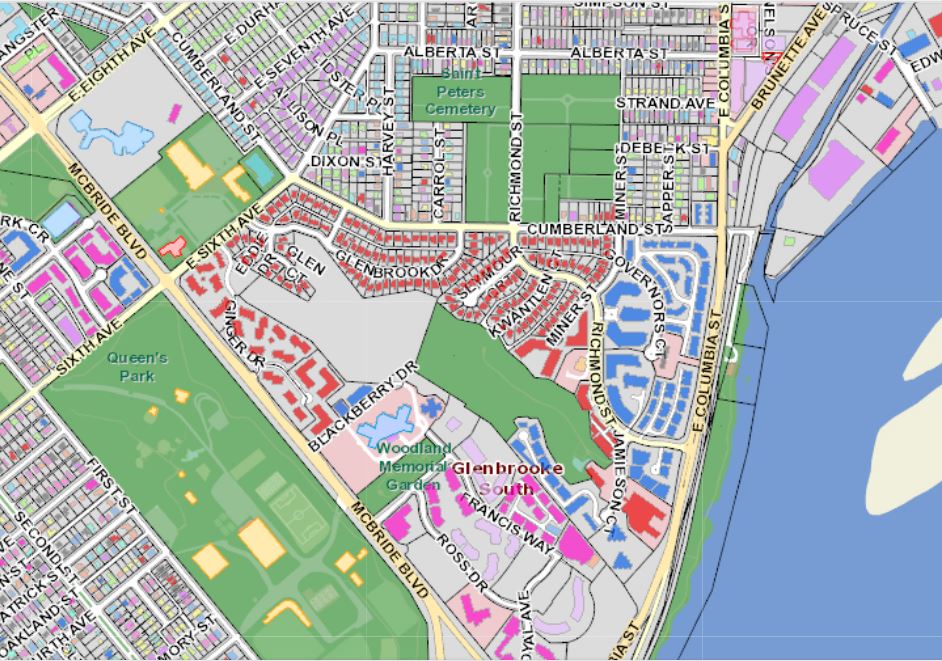

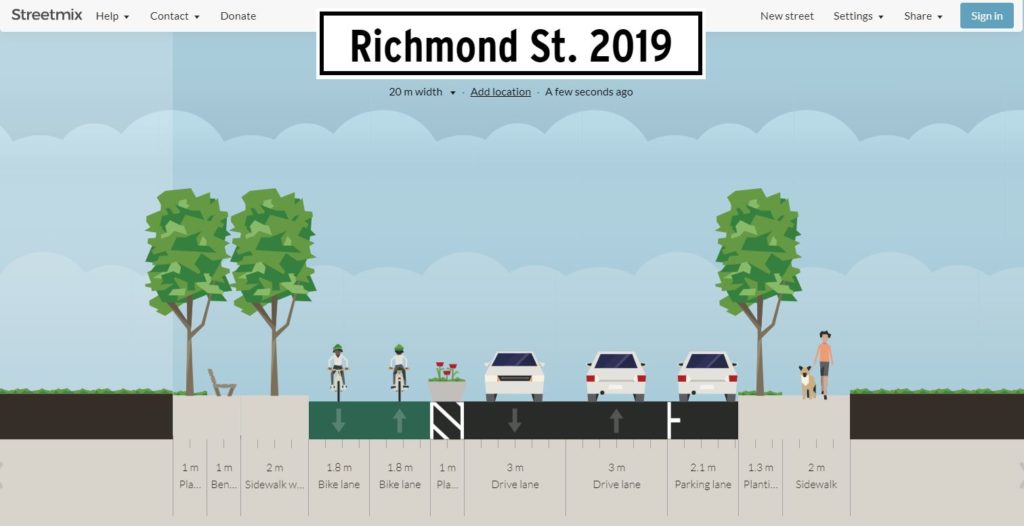 But that is just a representative cross section. There is another issue that makes the pedestrian experience even more uncomfortable. If you look at the intersection of Richmond and Miner, where staff were asked to evaluate placing a crosswalk, you see the corners are rounded off to facilitate higher turning speeds:
But that is just a representative cross section. There is another issue that makes the pedestrian experience even more uncomfortable. If you look at the intersection of Richmond and Miner, where staff were asked to evaluate placing a crosswalk, you see the corners are rounded off to facilitate higher turning speeds: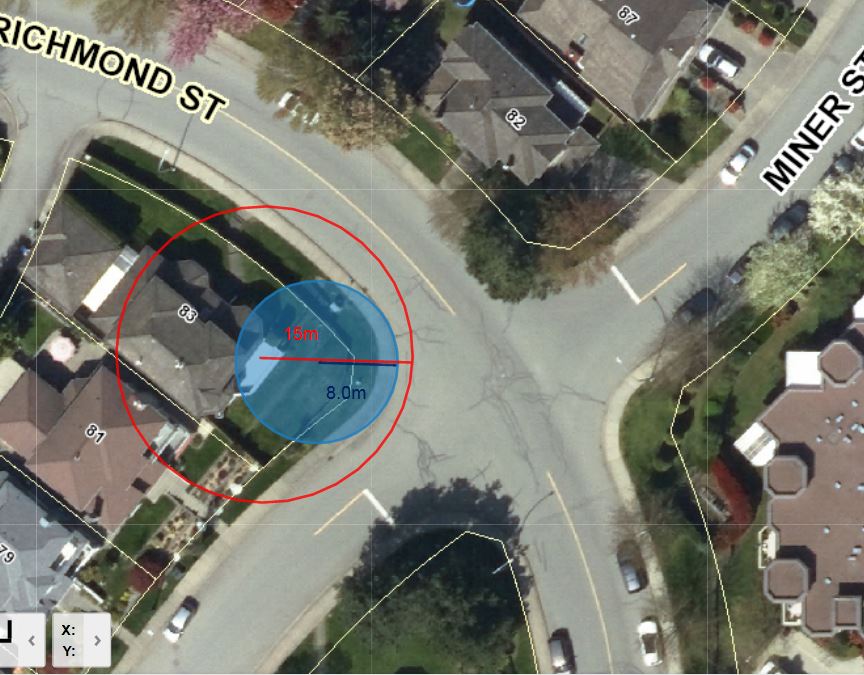 The technical term for this shape is “Corner Radius”. In this diagram you can see the curb follows a curve with a radius (blue) of about 8m, and the effective turning radius (tracing the track a vehicle would actually use for a right turn) is closer to 15m. By modern standards, this is a crazy wide corner, more suited for a race track than an urban area. Reading up on
The technical term for this shape is “Corner Radius”. In this diagram you can see the curb follows a curve with a radius (blue) of about 8m, and the effective turning radius (tracing the track a vehicle would actually use for a right turn) is closer to 15m. By modern standards, this is a crazy wide corner, more suited for a race track than an urban area. Reading up on 